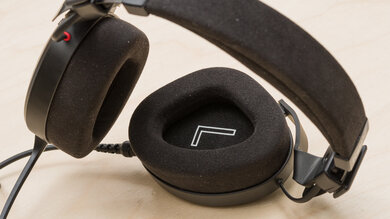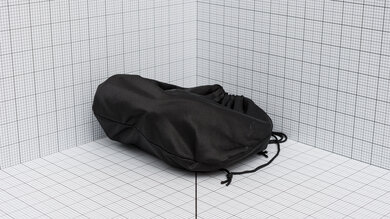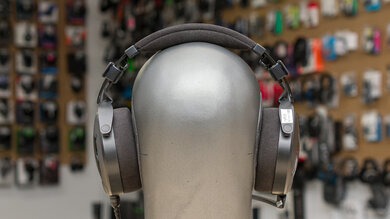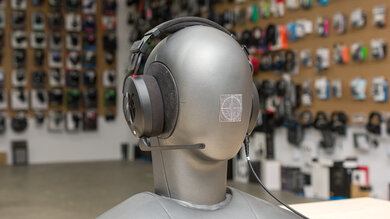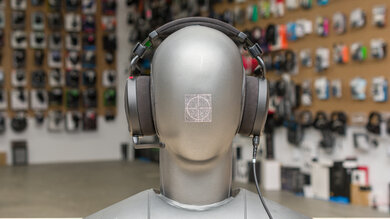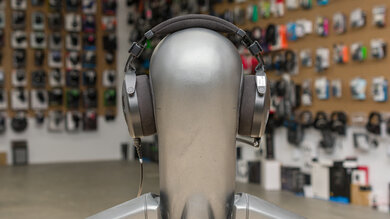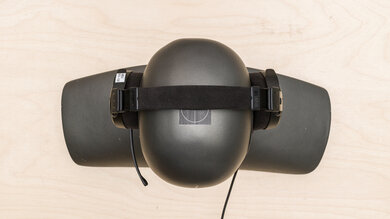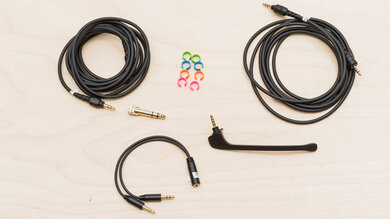While RØDE is well-known for its microphones and audio equipment, the Australian company released the RØDE NTH-100, its first pair of headphones, in the spring of 2022. This was followed by the RØDE NTH-100M variant, which have a detachable boom mic (that you can also purchase separately), in early 2023. These closed-back over-ears are designed for professional use, like mixing and monitoring audio, but can also be used for gaming thanks to the addition of a boom mic. They also fall close in price to other similarly designed headphones like the AKG K371 and the Audio-Technica ATH-M50x. The manufacturer advertises that their custom-matched dynamic drivers create an accurate sound with low distortion, but do they live up to the hype?
Our Verdict
The RØDE NTH-100 are satisfactory for neutral sound. They have a warm, round overall sound profile that delivers a bit of extra boom to mixes. For closed-backs, their bass lacks a bit of thump and rumble, though. Vocals and instruments are also recessed in mixes, so they sound weak, while sibilants like cymbals are veiled. That said, some people may still prefer the mellowness of the mids and treble, especially if you're using these cans for long mixing sessions, as this underemphasis can help reduce ear fatigue over time. That said, they have difficulty creating an out-of-head and spacious passive soundstage, although it's partially due to their closed-back design.
- Comfortable and well-built design.
- Detachable 1/8" TRS cable.
- Prone to inconsistencies in bass delivery.
- Distortion present at high volumes.
The RØDE NTH-100 are poor for commute and travel. While they're well-built and comfortable, they have a bulky design that can't fold into a more compact form, and their soft carrying pouch won't protect them from impact or water damage. Their wired design can also pose a snagging hazard. Since the cable's connector locks into the ear cup's port, if it gets caught on something, the headphones can be pulled off of your head. The headphones also can't passively block out the low rumble of bus and plane engines.
- Comfortable and well-built design.
- Poor noise isolation performance.
- Bulky and can fall off of your head with moderate movement.
The RØDE NTH-100 are disappointing for sports and fitness. They're not designed for this purpose as they can fall off your head with moderate movement. While their audio cable is detachable, it locks into place, so the headphones can be pulled off of your head if the cable snags something.
- Comfortable and well-built design.
- Prone to inconsistencies in bass delivery.
- Bulky and can fall off of your head with moderate movement.
The RØDE NTH-100 are sub-par for office use. Unfortunately, they struggle to block out ambient chatter and lack a microphone, so you can't answer or take calls with them. They also leak a bit of audio at high volumes, which may bother others around you. On the upside, they have a comfortable and well-built fit, so you won't feel fatigued if you wear them for long periods.
- Comfortable and well-built design.
- Prone to inconsistencies in bass delivery.
- Poor noise isolation performance.
The RØDE NTH-100 are wired headphones, and you can't use them wirelessly.
The RØDE NTH-100 are decent for wired gaming. Their warm sound profile can help bring out sound effects like footsteps while you game. They also have a comfortable fit suitable for long gaming marathons. However, they are prone to inconsistencies in bass delivery due to fit, seal, and position, so it's important to take the time to adjust them to your head to ensure a more consistent sound. If you have the original model, you can purchase the NTH-Mic separately or pick up the NTH-100M, which come with the boom mic. This mic ensures that your voice sounds clear and natural, though it has some trouble separating speech from noise, which can be annoying if you game in a noisy environment.
- Comfortable and well-built design.
- Excellent recording quality.
- Prone to inconsistencies in bass delivery.
- Mediocre noise handling.
The RØDE NTH-100M are fair for phone calls. The 'M' model comes with a boom microphone, but if you have the original model, you can also purchase the NTH-Mic separately. This mic offers excellent recording quality, so your voice sounds crystal clear. However, the mic has trouble separating speech from noise, and while your voice never gets completely lost in background sound, it's still annoying to hear.
- Excellent recording quality.
- Mediocre noise handling.
Changelog
- Updated May 17, 2024: The Differences Between Variants and Build Quality sections have been updated to acknowledge the issue and solutions the manufacturer offers regarding the headphones' locking mechanism breaking.
- Updated Apr 15, 2024: We re-checked our sound results to see if we could find out more about our unit's channel imbalance. We noticed a tester error in the process, which affected our results. We have retested all sound tests, and you can read more about the issue (and solution) in our Sound Profile test.
- Updated May 16, 2023: We've retested these headphones using the NTH-Mic. All of the Microphone tests have changed, and we have updated our review. We've also updated Wired, PC Compatibility, PlayStation Compatibility, and Xbox Compatibility to reflect their performance.
- Updated Apr 19, 2023: We've updated our review to reflect the RØDE NTH-100M, which are the same headphones as the RØDE NTH-100, but come with a detachable boom mic. You can find more information on this model in the Differences Between Sizes And Variants section. We will be testing the boom microphone's performance in the near future.
Check Price
Differences Between Sizes And Variants
The RØDE NTH-100 come in two variants, which have the same 'Black' color scheme: the original NTH-100 and the NTH-100M. The only differences are that the 100M model come with the following: a detachable boom mic called the NTH-Mic, as well as a 1/8" TRRS cable and a Y splitter cable. While we originally tested the NTH-100 model, and you can see our model's label here, you can also purchase the boom mic separately and add it to your pre-existing NTH-100 model. As a result, we purchased the NTH-Mic and tested it in this review. Additionally, the original release of the NTH-100M and NTH-100 have a smaller screw on the inside facing part of each headband locking mechanism, which has since been revised to a larger-sized screw meant to reduce the possibility of the plastic vice-like mechanism from cracking.
If you encounter another variant of these headphones, please let us know in the forums, and we'll update our review.
Popular Headphones Comparisons
The RØDE NTH-100 are professional headphones designed with mixing and monitoring in mind. They're often compared to the AKG K371 and the Audio-Technica ATH-M50x as they occupy the low-to-mid end price point and are closed-back over-ears. Unfortunately, they don't sound as neutral as their competitors and are prone to more distortion at high volumes. The RØDE have good build quality, thanks to their mixed plastic and metal materials, and a comfortable fit suitable for long listening sessions. You can also purchase a variant with a detachable boom mic if you want to use them for gaming or purchase the boom mic separately to add to your setup.
Check out our recommendations for the best studio headphones for mixing and recording, the best podcast headphones, and the best headphones for music.
The Beyerdynamic DT 770 PRO are better over-ears for neutral sound than the RØDE NTH-100M. The Beyerdynamic are better built, deliver audio more consistently across different re-seats, and have a more neutral sound profile, which some users may prefer, and their passive soundstage is more immersive. They also block out more ambient noise passively. However, the RØDE have a detachable audio cable, and the '100M' model come with a detachable mic if you want to use them for gaming.
The Audio-Technica ATH-M50x are better headphones for balanced sound than the RØDE NTH-100M. The Audio-Technica are better-built and deliver audio more consistently across different reseats. They also leak less audio at high volumes and can block out a bit more ambient noise. However, the RØDE come with a detachable boom mic for wired gaming.
Test Results

The RØDE NTH-100 are sleek headphones. The ear cups have a black satin finish with a large, glossy printed 'Ø' on each ear cup. The headphones come with colorful ID rings so that you differentiate or decorate your audio cables. You can also purchase additional cables in black, pink, green, orange, or blue. However, the headphones themselves only come in this black colorway.
The RØDE NTH-100 are comfortable headphones. The ear cups have cooling padding to help keep your ears from getting too warm during long listening sessions and don't clamp too tightly on your head. There's also a lock on each side of the adjustable headband to maintain your settings. However, the headphones can feel a little heavy on your head over time. If you have a big head or large ears, your ears may also touch the sides of the cups.
The RØDE NTH-100 aren't very portable, though they aren't for use on the go. They don't fold into a more compact form, and the ear cups can't swivel to lay flat. They come with a soft carrying pouch to protect the headphones when you're not using them.
These over-ears come with a soft pouch. While it won't protect your headphones from impact or water damage, it helps prevent scratches and dust build-up when you're not using them. However, the drawstrings don't close fully, leaving a gap that can expose your headphones to the elements.
The RØDE NTH-100M have a good build quality. They're made out of a mix of plastic and metal. Their headband locking mechanism represents a novel solution to getting the headphones sized just right, but it has been revised since we purchased our set due to user reports of the mechanism cracking on these and the standard version without the microphone. However, our unit hasn't had this issue. While the subsequently revised locking mechanism's screw is apparently an improvement, it still seems like a weak spot in the build, though we haven't reviewed a headset with the updated mechanism. Fortunately, the manufacturer has granted the headphones a lifetime warranty, so if your pair cracks, contact RØDE.
Like the Meze Empyrean, they also have Alcantara padding, which is a patented synthetic microfiber textile that feels soft and plush on the skin. The ear cups have removable memory foam padding and you can connect the audio cable to either the left or right ear cup, depending on your preferences. There's also a rubber cover that's meant to protect the port not in use. In addition to the cracking concern, the headband's a locking mechanism on each side so that you can maintain the same adjustment too. Unfortunately, you may force the locks if you forget to unlock them, and they could be prone to breakage as a result. The plastic part of the ear cups also feels a little cheap, and the glossy print is prone to scuffing over time.
With the audio cable connected to the left ear cup and the port cover in place on the right ear cup, the RØDE NTH-100 have an overall warm, round sound profile. They deliver a touch of extra boom to mixes while the rolled-off mids and treble mellow vocals and lead instruments, though this also makes them sound weak and distant. While they lack low bass for closed-back headphones, you may still find their amount of thump and rumble adequate for vocal-centric content. They don't sound as neutral as the AKG K371 or Audio-Technica ATH-M50x. That said, if you're using the NTH-Mic, you can also expect the frequency response to remain the same.
When we originally tested these headphones, we noticed mismatch present between our unit's left and right drivers. After noticing channel imbalance on another pair of headphones was caused by our test rig's silicone ear fixture, we've revisited this product and retested them to see if this was also the case here. However, in this case, the channel imbalance was related to an error in testing. Originally, only three human passes were performed, but they were derived from the same individual. These passes were default (no glasses, short hair), with glasses, and with long hair. As a result, we retested headphones using five passes done on five unique individuals. While the sound profile is still warm, the difference between the left and right driver is a lot less pronounced.
Some users have also expressed concerns regarding the quality control as there has been a report of audio quality differing between units. One user noticed that, when taking off the ear cup padding and putting it back into place, the headphones are prone to deviations in audio delivery. It may suggest a rupture in the seal between the pads' retention mechanism and the housing, even if you correctly connect all the locking pins. If you experience this issue, please let us know in the forums.
These headphones have good frequency response consistency. They're prone to inconsistencies in bass delivery, and you may especially notice a drop in bass if you have thick hair or glasses, as this can break the ear cups' seal on your head. However, if you take the time to ensure a better fit and seal, you'll achieve more consistent audio reproduction.
The RODE NTH-100's bass accuracy is great. While songs with a prominent bassline, like Kavinsky's Nightcall, are light on thump and rumble, the mid and high bass are much more present, which helps bring punch and warmth to mixes. If you're looking for audiophile-grade over-ears with a flatter bass response, check out the AKG K371 instead.
The RØDE NTH-100's mid accuracy is good. The response here is a bit tilted, so vocals and instruments have body but are pushed to the back of the mix. In songs like The Avalanche's Frontier Psychiatry, sample dialogue also sounds weak and distant.
The RODE NTH-100 have decent treble accuracy. Overall, this range is underemphasized, so vocals and instruments are veiled, further weakening detail. Sibilants like hi-hats are dull, too.
The RØDE NTH-100 have an excellent peaks and dips performance, which means they can control their sound profile quite well. Deviations are somewhat minor; there's a little bit of driver mismatch, so the left driver has more of a bump in the high bass than the right, which adds warmth to mixes. The following bump in the low-mid affects the right driver and clutters the mix. There's a bit of deviation in the treble range, so vocals and instruments sound clear, while sibilants like hi-hats are bright in both drivers.
The RØDE NTH-100 are the brand's first pair of headphones, so there's not much to compare them to. That said, for their first try, their imaging performance is great. Our unit's group delay falls below the audibility threshold, resulting in tight bass and transparent treble reproduction. There's a peak from the mid-bass to mid-mid in the phase response, though, which is noticeable with regular content. Audio is louder in the right driver, leaning the audio to the right. There's also some mismatch present in frequency response, which can create slight holes and imbalance in the stereo image. Imaging can vary between units, though, and can indicate a manufacturer's quality control and ergonomics.
The RODE NTH-100 have a sub-par passive soundstage, which is normal for closed-back headphones. The soundstage doesn't feel very wide, and sound seems like it's coming from inside your head rather than from speakers placed in the room around you. It also doesn't feel very spacious, although it sounds more natural and open than the AKG K371, which are similarly designed closed-back headphones.
The RØDE NTH-100 have an okay weighted harmonic distortion performance. Unfortunately, there are a few notable spikes, like the one in the low to mid-bass and throughout the mid range. The bass range peaks are less noticeable as the headphones struggle to reproduce this range. However, the mid-range peaks are audible with regular content and mixes sound impure. However, it's unlikely that most people will listen to audio at such a high volume. At normal listening volumes, distortion won't be noticeable.
These are the settings used to test these headphones. Our results are only valid when used in this configuration.
The RØDE NTH-100 have poor noise isolation. Although they have a closed-back design, they don't block out the low rumble of bus and plane engines and have a hard time cutting down ambient chatter. That said, they can reduce some of the high-pitched hums of an AC unit.
The RODE NTH-100 have a just okay leakage performance. Leakage is concentrated across the mid to treble range, which sounds fuller than in-ears and earbuds. If you're listening to audio in a shared environment, others around you may hear parts of it.
The original RØDE NTH-100 doesn't come with a mic, but you can purchase the NTH-Mic separately. They also come in an RØDE NTH-100M variant with the NTH-Mic in the box. You can connect the boom mic to the right ear cup and you'll have to twist them into place to lock the headphones into place. Overall, it's very easy to install the mic, and you can adjust it a bit to suit your needs. However, the mic isn't the most flexible.
The boom mic has an excellent recording quality. Your voice sounds clear, accurate, and full-bodied. You'll have no problems being heard clearly.
The boom mic has mediocre noise handling. The mic can capture your voice well if you're in a quiet room, but add in some noise, and the overall audio becomes more congested. The mic struggles to separate speech from noise, and while your voice is never completely lost or drowned out, background noise is always present in the audio, which is annoying.
The original model of these headphones come with a detachable 1/8" to 1/8" TRS cable and a 1/8" to 1/4" adapter. They also come with a couple of color-coded tags that you can use to identify or decorate your audio cable. You can buy colorful audio cables directly from the manufacturer too. They come with a port cover to protect the AUX jack when it's not in use, but it's very small and can be easy to lose.
If you have the '100M' model of these headphones, they come with an additional 8.04 ft (2.45 m) 1/8" TRRS cable and y-splitter.
These headphones can only receive audio when connected to a PC using their 1/8" TRS cable. However, if you're using their NTH-Mic, you'll also have mic support.
The RØDE NTH-100 can connect to your PlayStation console by plugging the audio cable into the controller. If you have the NTH-Mic, you can use it and receive audio.
By default, the RØDE NTH-100 don't have a mic and can only support audio via an analog connection to your Xbox console. However, if you have the '100M' model or purchased the NTH-Mic separately, you'll also gain mic support.


